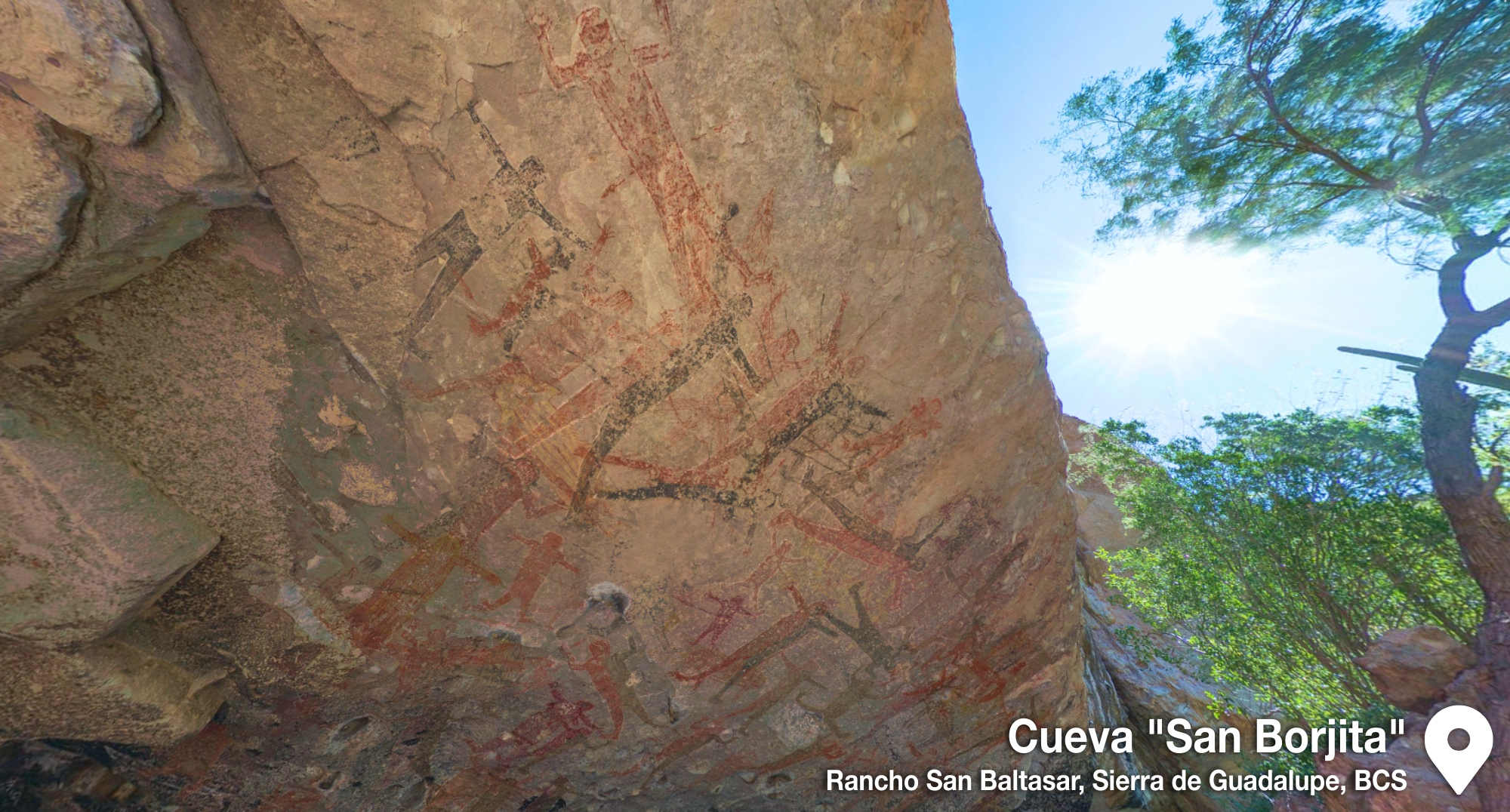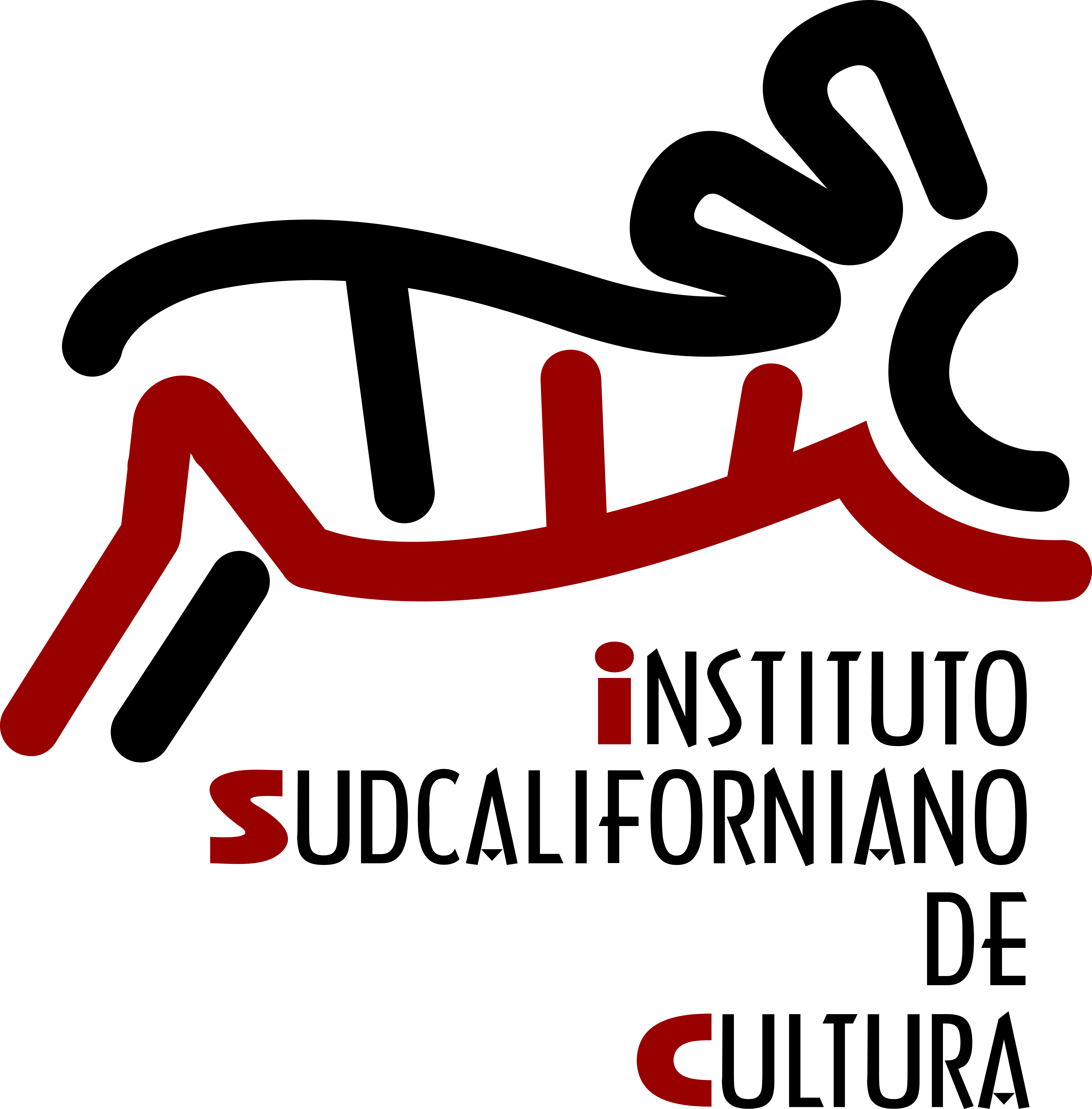San Borjita
La cueva de San Borjita es uno de los sitios con pinturas rupestres más largamente estudiado en la península de Baja California. Está localizado en un punto lejano de la sierra de Guadalupe, en el municipio de Mulegé, y es hasta hoy el espacio que da cobijo a una de las pinturas rupestres de mayor antigüedad en México y en el continente americano, pues una de las imágenes bicolor que se encuentra en su interior tiene una temporalidad de 9,000 años antes del presente. Uno de los valores que tiene este recinto es el de haber sido el primer sitio con pinturas rupestres estudiado en México. Esto ocurrió en la década del cincuenta del siglo pasado cuando el periodista Fernando Jordán llevó hasta allá a Bárbara Dalgren y Javier Romero, dándose así el inicio de los primeros trabajos de investigación de campo que buscaron desentrañar el pasado que ahí se conserva. Las indagaciones de estos investigadores fueron de avanzada en su tiempo ya que sus planteamientos fueron mucho más allá de las interpretaciones relacionadas con la magia de la cacería y demás temas de investigación que por ese tiempo se venían privilegiando en la explicación de las pinturas rupestres de otras partes del mundo. Aquel equipo de investigación realizó un trabajo de clasificación de las figuras pintadas en cuatro tipos, que son los siguientes: Cardones, porque evocan a las cactáceas que crecen en las cercanías; Espantajos, por parecerlo; Bicolores, donde también se incluyen figuras de un solo color; y las Excéntricas, que ellos pensaron estaban vinculadas a las creencias de los antiguos pobladores. Las indagaciones de estos investigadores fueron de avanzada en su tiempo ya que sus planteamientos fueron mucho más allá de las interpretaciones relacionadas con la magia de la cacería y demás temas de investigación que por ese tiempo se venían privilegiando en la explicación de las pinturas rupestres de otras partes del mundo. Aquel equipo de investigación realizó un trabajo de clasificación de las figuras pintadas en cuatro tipos, que son los siguientes: Cardones, porque evocan a las cactáceas que crecen en las cercanías; Espantajos, por parecerlo; Bicolores, donde también se incluyen figuras de un solo color; y las Excéntricas, que ellos pensaron estaban vinculadas a las creencias de los antiguos pobladores. Las indagaciones de estos investigadores fueron de avanzada en su tiempo ya que sus planteamientos fueron mucho más allá de las interpretaciones relacionadas con la magia de la cacería y demás temas de investigación que por ese tiempo se venían privilegiando en la explicación de las pinturas rupestres de otras partes del mundo. Aquel equipo de investigación realizó un trabajo de clasificación de las figuras pintadas en cuatro tipos, que son los siguientes: Cardones, porque evocan a las cactáceas que crecen en las cercanías; Espantajos, por parecerlo; Bicolores, donde también se incluyen figuras de un solo color; y las Excéntricas, que ellos pensaron estaban vinculadas a las creencias de los antiguos pobladores.
ARTE DE GIGANTES
Durante algún tiempo la cueva de San Borjita fue considerado por algunos interesados en el pasado peninsular como la "catedral de la pintura rupestre del continente americano", y descrita como la expresión de un "arte de gigantes" comparable al de otras culturas que lograron evolucionar en periodos posteriores. El conocimiento relativamente temprano de la cueva de San Borjita hizo suponer desde entonces el uso de andamios a base de troncos para poder pintar las figuras de gran tamaño en la parte más alta del techo de la cueva. Esta suposición acerca del uso de andamios fue altura considerada para otras cuevas de mayor que se localizan en la sierra de San Francisco. El estilo pictórico de las figuras de la cueva de San Borjita es diferente al de la sierra de San Francisco, y por eso se le dio el nombre de estilo Sierra de Guadalupe. Para Bárbara Dalgren las pinturas rupestres de San Borjita están representando una batalla que muestra la participación de distintos grupos o “clanes”, los cuales se pueden distinguir, según su opinión, en las diferencias del color de las figuras y los tocados de sus cabezas. San Borjita
SAN BORJITA
The San Borjita cave is
one of the most studied cave painting sites in the Baja California peninsula.
It is located in a distant point of the Sierra de Guadalupe, in the
municipality of Mulegé, and is until now the space that houses one of the
oldest cave paintings in Mexico and the American continent, as one of the
bicolor images found in its interior has a temporality of 9,000 years before
the present. One of the values of this site is having been the first site
with cave paintings studied in Mexico. This happened in the fifties of the last
century when the journalist Fernando Jordán took Bárbara Dalgren and Javier
Romero there, starting the first field research work that sought to unravel the
past that is preserved there. The investigations of these researchers were
ahead of their time since their approaches went far beyond the interpretations
related to the magic of hunting and other research topics that at that time
were privileged in the explanation of cave paintings from other parts of the
world. world. This research team did a job classifying the painted figures into
four types, which are the following: Cardones, because they evoke the cacti
that grow nearby; It seems scary; Two-color, which also include figures of a
single color; and the eccentrics, who thought they were linked to the beliefs
of the ancient settlers. This research team did a job classifying the painted
figures into four types, which are the following: Cardones, because they evoke
the cacti that grow nearby; It seems scary; Two-color, which also include
figures of a single color; and the eccentrics, who thought they were linked to
the beliefs of the ancient settlers. This research team did a job classifying
the painted figures into four types, which are the following: Cardones, because
they evoke the cacti that grow nearby; It seems scary; Two-color, which also
include figures of a single color; and the eccentrics, who thought they were
linked to the beliefs of the ancient settlers. |
For some time the cave of San Borjita was considered by some
interested in the peninsular past as the "cave painting cathedral of the
American continent", and described as the expression of an "art of
giants" comparable to other cultures that managed to evolve in later
periods. The relatively early knowledge of the San Borjita cave has led to the
use of log-based scaffolding since then to be able to paint large figures on
the highest part of the cave roof. This assumption about the use of scaffolding
was considered for other caves of greater height that are located in the San
Francisco mountain range. The pictorial style of the figures in the San Borjita
cave is different from that of the San Francisco mountain range, and that is
why it was given the Sierra de Guadalupe style name. For Barbara Dalgren the
cave paintings of San Borjita are representing a battle that shows the participation
of different groups or "clans", which can be distinguished, according
to their opinion, in the differences in the color of the figures and the
headdresses of their heads. San Borjita.
Enlace Audio libro: Pinturas Rupestres Misiones y Oasis de la Baja California https://bit.ly/32CfTlw


